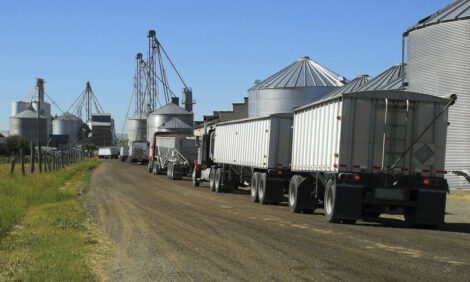



Weekly Australian Cattle Summary
AUSTRALIA - This report is a collection of weekly cattle price summaries from each Australian state by the Meat & Livestock Australia.
SA weekly cattle summary
Smaller numbersNaracoorte’s sale last Friday could only attract 326 cows and bulls. The cows attracting strong competition from the South East and Victorian processors that left a couple out of the equation, as most carcase weights prices ranged between 290¢ and 335¢/kg.
The SA LE’s sale attracted mainly young cattle, with numbers falling. They sold to erratic competition from the usual trade and processor buyers, while feeder orders were active on lightweight vealer and yearling steers. Small numbers of export categories failed to create that much interest, with the grown steers under 160¢ and most cows 110¢ to 145¢/kg.
Naracoorte’s young cattle and grown steers sale was slightly reduced and was probably due to many producers not being able to get stock off their properties after the heavy rainfall last weekend, and reports that numerous trucks were getting bogged the previous week. Overall quality was very good with many pens of grass and supplementary fed yearling being yarded and tending to attract solid trade and processor competition from both sides of the border, with a NSW order also sourcing limited numbers. Feeder and restocker orders were a little hamstrung by the good finish and the extra weight that many yearlings were carrying.
Mt. Gambier had 1a reduced yarding was also affected by the very wet conditions in the lower South East, and sold to very strong competition, with most of the usual buyers making purchases. Millicent agents put together a larger yarding for its fortnightly sale, with overall quality also improving.
With quality improving and many Victorian producers being unable to yard stock, there were generally dearer trends on most categories as the regular buying contingent lifted their rates. Vealer steers to the trade and local butchers sold from 195¢ to 228¢, with most sales around 3¢/kg dearer. Feeder and restocker orders sourced C2 steers between 190¢ and 201¢, or 3¢ to 7¢/kg more. Vealer heifers to the trade sold from 175¢ to 217¢ at rates 1¢ to 3¢/kg higher. Feeder purchases of C2 heifers ranged between 185¢ and 202¢ at slightly dearer levels. Yearling C3 steers to trade inquiry sold mainly between 176¢ and 205¢ to be unchanged to 11¢/kg dearer. Feeder C2 purchases were from 172¢ to 188¢/kg. Yearling heifers attracted solid competition with C3 sales mostly 175¢ to 203¢ and unchanged to 5¢/kg dearer.
Grown steer C3 and C4 sales were generally between 180¢ and 210¢ to be 5¢ dearer for the medium weights and slightly less for the heavyweights, as carcase weight prices averaged close to 340¢/kg. Cows continue to attract strong inquiry, with most D3 to C6 medium and heavyweight beef cows selling from 130¢ to 170¢, and mainly in a 290¢ to 330¢/kg cwt range.
WA weekly cattle summary
More seasonal hopeCattle throughput at MLA’s MLRS reported physical markets in WA fell 5 per cent compared to last week but is 7 per cent above the corresponding week last year. Despite some recent rainfall in the Pilbara, Murchison and Gascoyne regions conditions in much of the northern pastoral regions remain very dry and the prolonged drought continues to plague pastoralists. In the south of WA conditions remain wide spread, but overall the seasonal rainfall has remained well below average. In some traditional cattle areas of the southwest feed conditions are fair, while other areas continue to see limited growth from pastures and remain worried about water levels in storage dams. There remains hope for a reasonable finish to the season with forecasts predicting a wetter than average finish to this years spring and a prolonging of the growing season would certainly be a welcome addition to what has been a tight season. Many producers continue to struggle with tight feed conditions and have reported uncertainty as to the weight and quality of their cattle turnoff this year be they yearlings or new season vealers. Pastoral cattle supplies forwarded to Muchea remain solid, while the volumes of cows and heavy weight export cattle from the north also remain buoyant on a direct to works basis. As has been the case for much of this year the supplies of locally bred heavy weight steers and heifers remained negligible, as were trade weight grass and grain finished yearlings, while cow numbers remained buoyant. At Great Southern young cattle in store condition were the largest categories to be offered.
East active in marketThere continues to be a slight but discernable turnoff of lightweight vealers in physical market as producers try to maximise tight levels and protect the condition of their maternal herds. Demand from both the local trade and restockers was fair this week on a mixed quality offering. The tight numbers of grass finished trade yearling steers saw little or no change, while a mixed quality grass heifer offering late in the week at the Great Southern saleyards failed to impress and a weak trade demand was recorded. Subsequently rates were cheaper with the majority purchased by restockers and turnover operators. There was again a reasonable competition recorded from eastern states restocker who have again been buoyed on by impressive seasonal conditions back home. Agents have also reported an increase in inquiry as to when there will be good numbers of new season vealers available in WA and it is possible that there will be increased numbers of these cattle flowing to east just prior to and after Christmas. The heavy weight prime cow market saw a rebound in trade demand after the losses seen towards the end of last week. Plainer cow classes recorded an increase in demand including one eastern states processor.
Rain depletes supplyRainfall over the weekend and early in the week once again hampered the mustering and transport of cattle across the state. As a consequence throughput at MLA’s NLRS reported physical markets experienced a fall of 27 per cent. Supply is expected to remain tight for some weeks with producers hanging onto unfinished cattle. All the saleyards recorded a lower throughput except Goulburn which recorded a 40 per cent increase, the yarding mostly consisted of vealers in 2 score condition suitable for restockers and feeders.
Despite the fall in supply quality was reportedly improved at a number of selling centres. More cattle are being offered coming off crops or being supplementary fed. There were still a fair proportion of young cattle in unfinished condition suited to restockers and feeders. At Armidale a lot of the young cattle were lightweight and attracted spirited competition from both restockers and processors. Throughput for most categories was reduced, vealer steer numbers were back 13 per cent, vealer heifer numbers slipped 34 per cent, yearling steers 22 per cent, yearling heifers were the only category to increase albeit by only slightly, grown steers were back 40 per cent and the cow offering eased 30 per cent.
Most of the usual feeder and processor buyers were present and active across the state along with restocker competition on unfinished lines. A regular processor and feeder buyer was not present at Wagga which influenced some price trends. At Armidale despite not all the processor buyers being present competition was strong and some buyers finished the sale without fulfilling their requirements, largely due to the lack of finished lines meeting specifications.
Calves to restockers reached 294¢ to mostly average 258¢/kg. Lightweight vealer steers to slaughter were firm averaging 218¢, medium weights to trade buyers gained 4¢ to sell around 213¢/kg. Those returning to the paddock gained 3¢ and after reaching 233¢ averaged 218¢/kg. Lightweight vealer heifers topped at 225¢ and averaged firm at 216¢/kg. Medium weight vealer heifers to process improved 3¢ to mostly make around 208¢ as the limited number of heavy weights averaged 190¢/kg. Lightweight yearling steers to feed and restock sold firm to 5¢ dearer selling from 206¢ to 212¢/kg. Medium weights to feed and restock on the other hand sold 4¢ cheaper, achieving averages from 194¢ to 199¢/kg. Those to processors gained 2¢ to 198¢ as heavyweight C3’s averaged 192¢/kg. Processors paid an average of 194¢ for lightweight yearling heifers, 191¢ for medium weights and 181¢/kg for heavyweights. Restockers paid to 215¢ for lightweight heifers but most settled around 194¢/kg.
Heavyweight grown steers gained 3¢ to 4¢ selling to 199.6¢ and averaging 186¢ to 188¢/kg. Bullocks remained firm averaging 184¢/kg. Medium D3 cows gained 2¢ to 143¢/kg. Heavyweights gained 2¢, D3’s averaged 152¢ and D4’s mostly settled around 153¢ after reaching 168¢/kg.
QLD weekly cattle summary
Wet weather reduces supplyWidespread falls of follow-up rain across a large portion of the state reduced the flow of stock into the saleyards. However the supply of cattle at Mareeba went against this movement with numbers increasing to the highest level for the year. The wet conditions cancelled some markets plus restricted the supply at others and overall at physical markets covered by MLA’s NLRS numbers fell by 55 per cent.
Despite the good season in most districts the overall quality of stock was mixed with some fair samples of store condition grades offered, as producers in the few unfavourable areas take advantage of a strong market for restocker and feeder classes. Young lightweight cattle to restockers backgrounders and the trade continued to experience very strong competition. Vealer heifers and lightweight yearling heifers met improved demand from local and interstate processors and average prices lifted by 7¢ to 10¢/kg. Lightweight yearling steers returning to the paddock also continued to climb in value with a good sample gaining around 4¢/kg. However heavy yearling heifers to the trade went against the trend of a firm to a dearer market and averaged over 10¢/kg cheaper.
Heavy steers to export slaughter generally met a firm market, and bullocks across all markets experienced no change in value, however with a fair sample of some older grades included in the penning at Dalby average prices eased by 4¢/kg. Cow values improved by 3¢ to 9¢/kg with very strong support from restockers on the light condition grades. PTIC lines received particular strong competition from restockers with prices reaching a very high level, and average values jumped by 26¢/kg.
Calves to the trade averaged 179¢ and sold to 218.2¢, while those returning to the paddock averaged 213¢ and sold to 238.6¢/kg. A handful of well bred vealer steers averaged 200¢ and sold to 215.2¢/kg. A relatively good supply of vealer heifers came forward and sold to the trade 10¢ dearer at 202¢ with some heavy grades to local butchers reaching 223.2¢/kg. The vast majority of lightweight C2 yearling steers returned to the paddock 4¢ better at 213¢ with sales to 228.2¢/kg. Medium weight grades to feed averaged 200¢ and heavy classes mostly so around 184¢/kg. Lightweight yearling heifers to restockers averaged 202¢ while trade descriptions averaged 7¢ dearer at 198¢ with a few pens reaching 218.2¢/kg. Medium weight yearling heifers to the trade averaged 186¢ and heavy classes lost 13¢ to average just under 170¢ with a few to 195¢/kg.
Heavy steers to export slaughter averaged 181¢ and sold to 194.2¢ while the bullock portion mostly so around 180¢ with some to 190¢/kg. Lightweight E muscle score 2 cows averaged 88¢, and medium weight D muscle grades averaged 121¢/kg. PTIC cows sold to a top of 174.2¢ with a good sample around 167¢/kg. Good heavy cows averaged 3¢ better at 151¢ the occasional pen to 164.2¢/kg.
TheCattleSite News Desk


